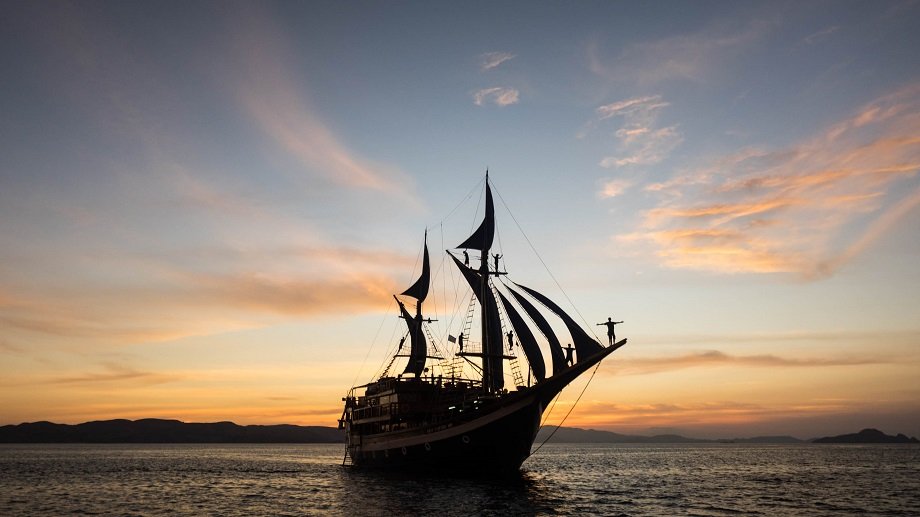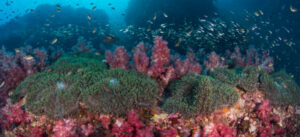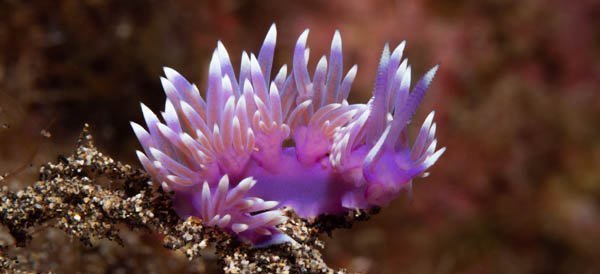Komodo Island
Komodo Island
 The volcanic island of Komodo (along with Padar, Rinca and an archipelago of smaller islands) is a part of Komodo National Park, an area that was founded in 1980 and declared a UNESCO World Heritage Site in 1991. The national park was formed to protect, and is an eponym of, its most famous denizen--the mighty Komodo dragon (Varanus komodoensis), the world's largest and most dangerous lizard.
The islands are located in one of the most arid regions in Indonesia and their rugged volcanic hills are blanketed in a mix of prickly shrublands and savanna grasslands, with a smattering of forest here and there. The highly irregular coastlines of the islands consist of a multitude of inlets and bays with fantastic beaches that are divided up by high headlands that fall steeply into the sea. The islands are also part of the coral triangle and the waters that surround them are some of the most bio-diverse areas on the planet.
Komodo is a very hard place to describe, as words just seem to do no justice. Just have a look at the video above instead and answer me this, how does one not get lost in reverie when immersed in such idyllic surroundings?
The volcanic island of Komodo (along with Padar, Rinca and an archipelago of smaller islands) is a part of Komodo National Park, an area that was founded in 1980 and declared a UNESCO World Heritage Site in 1991. The national park was formed to protect, and is an eponym of, its most famous denizen--the mighty Komodo dragon (Varanus komodoensis), the world's largest and most dangerous lizard.
The islands are located in one of the most arid regions in Indonesia and their rugged volcanic hills are blanketed in a mix of prickly shrublands and savanna grasslands, with a smattering of forest here and there. The highly irregular coastlines of the islands consist of a multitude of inlets and bays with fantastic beaches that are divided up by high headlands that fall steeply into the sea. The islands are also part of the coral triangle and the waters that surround them are some of the most bio-diverse areas on the planet.
Komodo is a very hard place to describe, as words just seem to do no justice. Just have a look at the video above instead and answer me this, how does one not get lost in reverie when immersed in such idyllic surroundings?
Getting There
The launching point for trips to Komodo National Park is from the small town of Labuan Bajo that lies on the north-west corner of the island of Flores in Indonesia. One can take a ferry or a live-on-board (LoB) boat from Bali or Lombok to get to Flores, but the most convenient and popular way to get there, especially for tourists, is by taking one of the frequent flights out of Denpasar in Bali to Labuan Bajo from airlines such as Sriwijaya or Garuda. Once you land in the tiny airport and collect your check-in luggage, avoid the touts that are lying in wait outside by heading straight to the taxi counter. Here you can purchase a IDR60k ticket for a taxi that will take you on the ten minute ride to the main road (Jl. Soekarno Hatta) of Labuan Bajo town.
Nearest Hyperbaric Chamber
Sanglah General Hospital Bali USUP Sanglah Denpasar JI. Diponegoro, Denpasar 80114 Bali Telephone: +62 (361) 227911 through to -15 (ext. 232) Fax: +62 (361) 22426Labuan Bajo
Think of Labuan Bajo as a temporary launching point, or just a place to head back to for a night's sleep. The small town is dusty and grimy, and the one-way street that cuts through the town is lined with throngs of tourists that flit back and forth from the (more than twenty) dive shops to the warungs and over-priced bars that are scattered along the stretch. The street is fairly narrow and the traffic can be fast and reckless at times, so be wary. There are several options that you can take to head out to the island if you do decide to use the services of one of the dive shops, but bear in mind that all the options will require the following additional payments:
- National Park fees of IDR150k per person, per day, from Monday to Saturday; and IDR225k per person, per day, for Sundays and public holidays
- Area Tax fee of IDR50k per person, per day
- A mandatory guide (one guide for every five people) fee of IDR80k per guide, when hiking on the islands
- Camera fees are IDR50k per camera and IDR150k per video camera
- Diving fees of IDR25k per person, per day, if you go for a dive trip
- Snorkeling fees of IDR15k per person, per day, if you go snorkeling instead
Live-on-Boards
Alternatively, you have the live-on-boards (LoB). The one we took was called 'Sea Safari VII', a purpose-built, and very large (37.5m long and 10.65m wide) ironwood schooner. The yacht resembles a traditional Indonesian two-masted sailing ship called a 'pinisiq', and is equipped with 14 air-conditioned cabins with private bathrooms spread out over its three decks. There are plenty of amenities on board, including a restaurant, a lounge, and a camera station for underwater cameras. Aside from the standard safety and navigation equipment (GPS, radar, VHF radio systems, satellite phones), ENOS systems are also available. This was quite comforting for us especially since a diver had gone missing just before our trip began.

Diving Komodo
Currents tend to be very strong in the waters of Komodo National Park as the region is a part of the Indonesian through-flow, where warm, tropical water flows from the Philippines and through the Flores sea before being forced through the 'gaps' of Nusa Tenggara (Lombok, Sumbawa, and Flores) to the Indian Ocean to the south. These 'gaps' are the Lombok Strait (between Bali and Lombok), the Ombai Strait (between Alor and Timor), and the Sape Strait (between Sumbawa and Komodo), where the shelf drops down to hundreds of metres. The waters around Komodo also receive a lot of nutrients from the much colder water from the Indian Ocean to the south. This water flows up in the form of upwellings, where deeper water that is highly rich in nutrients collides with the continental shelf and is forced to rise to the surface. The nutrient-rich water increases the numbers of zooplankton (such as shrimp and krill), which in turn attracts large filter-feeders like the manta rays but also drops the visibility. These nutrients give the area a staggering diversity of marine life, with thousands of species of fish and hundreds of species of coral. Once you get into the water, it is easy to see why Komodo National Park was named a UNESCO World Heritage Site. The combination of the warm Indonesian through-flow and the cool Indian Ocean upwellings, create two very distinct marine habitats in Komodo National Park that are separated by just a few kilometres: the northern tropical area which has an average water temperatures of 27-28 degrees C and a visibility of 25-35 metres, and the southern temperate area which has an average water temperatures of 23-24 degrees C and a visibility of 7-18 metres. The sheer number of irregular islands around the park also create smaller channels that the strong currents can flow through. This creates plenty of opportunity for exciting, yet relaxing (but potentially dangerous), drift dives.
Interactive Location Map
- Batumonco
- Loh Wenci
- Sarikaya
- Banana Split
- Batu Saloka
- Nisaleme
- Letuhoh
- Manta Alley
- German Flag
- Lengkohi
- End Of The World
- Toko Toko
- Castle Rock
- Crystal Rock
- Lighthouse
- Cauldron
- Golden Passage
- Tatawa
- Makassar
- Batu Bolong
- Siaba
- Pengah
- Bonsai
- Wainilu
- Batu Tiga
- Pink Beach
- Loh Namu
- Loh Sera
- Batu Gaja
- Three Sisters
- Pilaarsteen
- Torre Sie
- Torpedo Point
- Cannibal Rock
- Yellow Wall
- Crinoid Canyon
My Top Three Dive Sites
1. The Cauldron (a.k.a. Shotgun)
This was my favourite site not only because of the marine creatures that we saw there but because of the unique geography that turns the 'Cauldron' into the 'Shotgun' when currents are very strong. The dive site lies in a narrow channel between the islands of Gili Lawa Laut and Gili Lawa Darat. You normally start the dive on a sloping wall at a depth of 20-25 metres, approximately 100 metres west of the channel (the site can also be dived east to west when the current switches, but the visibility tends to be a little lower). The drift takes you past bommies and sand fields but gradually carries you up and into shallower water as you near the huge, circular formation that gives the site its name. White-tip reef sharks (Triaenodon obesus) can be found circling all around the area. There is a grotto on the left side of the cauldron where large fish, such as the giant trevally (Caranx ignobilis) hang above you in the current, where sunlight shimmers across their silver bodies. When leaving the cauldron via the passage, the current usually picks up as it gets shallower. Divers normally hook in to the slope as feeding devil rays (Mobula sp.) and white reef mantas (Manta alfredi) are frequently seen here. When you dive the site as the 'shotgun', you need to be careful as the strong currents funnel you into the passage and can whip you upwards as it gets shallower, so be sure to keep a very close eye on your depth and ascent rate!
2. Castle Rock
Castle Rock is one of Komodo's most famous dive spots. The dive site is a rocky mound that lies directly in the path of strong currents, and thus gives shelter to a huge variety of marine wildlife--hence its name. White-tipped reef sharks (Triaenodon obesus) and other large pelagics, such as the ocellated eagle ray (Aetobatus ocellatus) are frequently seen here. Lying closer to the reef are a variety of creatures from crustaceans like the peacock mantis shrimp (Odontodactylus scyllarus) to tiny macro critters like nudibranchs and Bargibant's pygmy seahorses (Hippocampus bargibanti) hiding in their hosts, pink gorgonian seafans (Muricella plectana).
3. Batu Bolong
Batu Bolong is another rocky pinnacle that sticks out from the depths of the ocean, that lies between Tatawa and Komodo island. The pinnacle has a large hole in it which is why it is sometimes referred to as 'Hollow Rock'. The steep wall provides you with magnificent reefscapes and hosts a bewildering number of marine life. The fish diversity here is absolutely breathtaking, with dense schools of anthias, triggerfish, moray eels, plenty of blennies, and the usual reef fish that you encounter when diving around Indonesia. Larger pelagics like the Malabar grouper (Epinephelus malabaricus) can also be seen slowly cruising around, as mantis shrimps (Odontodactylus scyllarus) scuttle around frantically from nook to nook, their pinchers wound-in ready to strike. Plenty of nudibranches, like the strikingly vibrant Nembrotha purpureolineolata, can be found crawling around slowly down below. The dive site can only be dived when the current is (relatively) weak as powerful downward currents sometimes wreak havoc here.
Next: Komodo Island (Part 2) - Marine Life
Indonesia Overview




